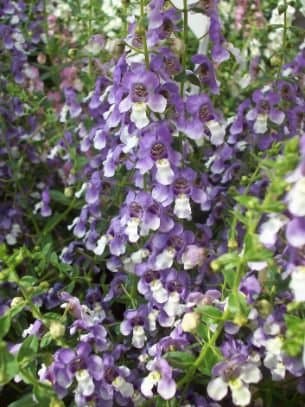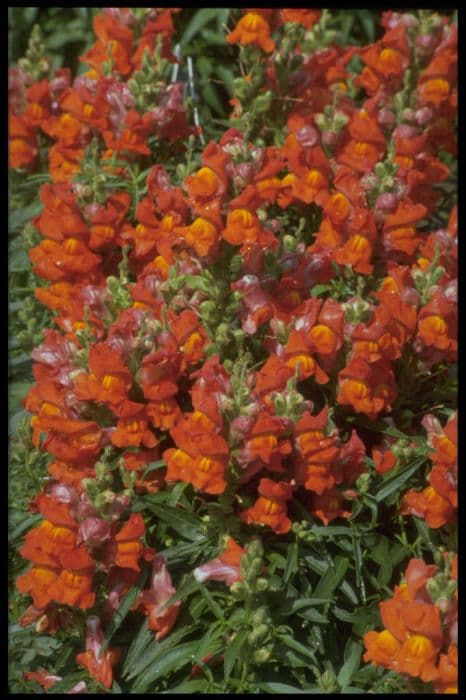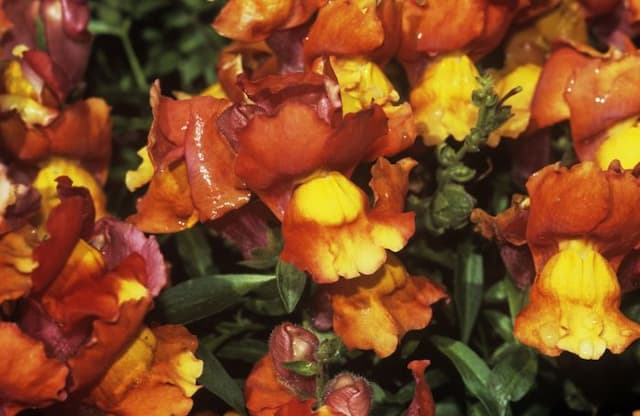Hebe Hebe 'Pewter Dome'

ABOUT
Hebe 'Pewter Dome' boasts a mound-like appearance composed of small, dense, spear-shaped leaves displaying a distinctive silver-grey color. The foliage often takes on a subtle blue hue that contributes to the plant's striking visual impact. During the blooming period, the plant becomes adorned with short spikes of purple or violet flowers, which contrast spectacularly against the silver-toned leaves. These blooms typically gather in clustered formations at the tips of the branches, adding a touch of vibrant color to the otherwise muted pewter color palette of the foliage. The overall texture of the plant is somewhat coarse to the touch due to the robust nature of the leaves and stems. The impression given by Hebe 'Pewter Dome' is that of a compact, rounded shrub with an elegant yet hardy appeal, capable of providing year-round interest in garden landscapes.
About this plant
 Names
NamesFamily
Plantaginaceae
Synonyms
Pewter Dome, Shrubby Veronica
Common names
Hebe 'Pewter Dome'.
 Toxicity
ToxicityTo humans
The Hebe plant, commonly referred to by its genus name Hebe, is not widely known for being poisonous to humans. However, it is always advisable to exercise caution as sensitivity can vary among individuals. If any part of the plant is ingested, symptoms may not be significant but could potentially include mild gastrointestinal upset. There is limited information on the severe toxicity of Hebe 'Pewter Dome' to humans, so it is recommended to avoid ingestion and to keep the plant out of reach of children who might accidentally consume it.
To pets
The Hebe plant is similarly not recognized as highly toxic to pets. Nevertheless, pets may experience mild gastrointestinal discomfort if they ingest parts of the plant, including symptoms such as vomiting or diarrhea. To be cautious, it is best to keep Hebe plants out of reach of pets, especially if they are known to chew on plants. If you suspect your pet has ingested a significant amount of the plant and is showing adverse symptoms, consult with a veterinarian.
 Characteristics
CharacteristicsLife cycle
Perennials
Foliage type
Evergreen
Color of leaves
Grey-green
Flower color
Lilac
Height
2 feet (0.61 meters)
Spread
2 feet (0.61 meters)
Plant type
Shrub
Hardiness zones
7
Native area
New Zealand
Benefits
 General Benefits
General Benefits- Visual Interest: The Hebe 'Pewter Dome' offers attractive foliage and structure to a garden, with its silvery-green leaves and dome-shaped habit.
- Low Maintenance: This plant is known for being easy to care for, requiring minimal pruning and tolerating a range of soil types.
- Drought Tolerance: Once established, Hebe 'Pewter Dome' has a good level of drought resistance, making it suitable for xeriscaping and dry climate gardens.
- Long Flowering Season: It produces purple or violet flowers in late spring to early summer, which can last for several weeks, providing a long-lasting display.
- Attracts Wildlife: The flowers attract bees, butterflies, and other beneficial insects, which are important for pollination and the overall health of the garden.
- Versatility: With its compact size, Hebe 'Pewter Dome' is suitable for various garden settings including borders, rockeries, and containers.
- Evergreen: Being an evergreen shrub, it provides year-round color and structure to the garden, even in the winter months.
- Hardiness: Hebe 'Pewter Dome' is fairly hardy and can withstand cold temperatures, making it suitable for many temperate gardens.
- Sea Air Tolerance: This plant is good for coastal gardens as it can handle salty air better than many other plants.
 Medical Properties
Medical PropertiesThis plant is not used for medical purposes.
 Air-purifying Qualities
Air-purifying QualitiesThis plant is not specifically known for air purifying qualities.
 Other Uses
Other Uses- Artistic Photography: Hebe 'Pewter Dome' can be used as an attractive subject for floral and garden photography due to its unique silver-gray foliage and compact shape.
- Floral Arrangements: The stems and leaves can be used in fresh or dried floral arrangements for their texture and subtle color contrast.
- Educational Tool: Hebe 'Pewter Dome' can be utilized in educational settings, such as schools or botanical gardens, to demonstrate plant pruning techniques and discuss evergreen plant care.
- Erosion Control: The dense habit of this plant makes it useful for stabilizing slopes and areas prone to erosion in the garden.
- Culinary Decoration: Although not for consumption, leaves of Hebe 'Pewter Dome' can adorn platters and buffet tables for added greenery in culinary displays.
- Aquarium Decoration: The leaves may provide an interesting aesthetic when used as decorative elements in the design of paludariums – a type of vivarium that includes both terrestrial and aquatic elements.
- Seasonal Festivities: Its evergreen nature allows it to be incorporated into winter holiday decorations, such as wreaths or tabletop arrangements.
- Miniature Gardens: The small, dome-shaped form of 'Pewter Dome' is ideal for creating miniature or fairy gardens, providing a realistic shrubbery at a smaller scale.
- Bonsai Practice: For enthusiasts looking to try bonsai with non-traditional plants, Hebe 'Pewter Dome' can be a challenging yet unique candidate to shape and maintain.
- Landscape Design Teaching Aid: This plant can be used as a live example in landscape design courses to illustrate principles of form, texture, and plant compatibility in garden settings.
Interesting Facts
 Feng Shui
Feng ShuiHebe is not used in Feng Shui practice.
 Zodiac Sign Compitability
Zodiac Sign CompitabilityHebe is not used in astrology practice.
 Plant Symbolism
Plant Symbolism- Youthful Vibrancy: The genus Hebe was named after the Greek goddess of youth, reflecting the plant's lush, evergreen foliage that symbolizes eternal youth and freshness.
- Protection: With its dense, dome-shaped habit, Hebe 'Pewter Dome' can symbolize protection and shelter, offering a sense of safety and comfort.
- Unity: The rounded form of the plant can represent unity and completeness, making it a symbol of togetherness and wholeness in relationships or families.
- Endurance: The robust nature of Hebe 'Pewter Dome', which can withstand various conditions, may symbolize endurance and adaptability in the face of challenges.
 Water
WaterFor a Hebe 'Pewter Dome', also known as simply Hebe, water thoroughly whenever the top inch of soil feels dry to the touch, which typically means once every week during active growing seasons like spring and summer. In the cooler months of fall and winter, reduce watering frequency to every other week or less, depending on the humidity and temperature of your environment. Use room temperature water and gently pour it around the base of the plant until you see water begin to drain from the bottom of the pot, indicating the soil is fully saturated. Be cautious not to overwater, as Hebe plants do not like to sit in waterlogged soil. Generally, it's better to aim for steady, even moisture rather than a fixed amount of water; however, if you are looking for a guideline, use about half a gallon for a medium-sized plant at each watering session.
 Light
LightHebe 'Pewter Dome' thrives in a spot that receives full sun to partial shade. An ideal location would be one where the plant can enjoy several hours of morning sunlight with some dappled or light shade in the afternoon. Avoid placing your Hebe in deep shade, as this can lead to poor foliage color and reduced flowering.
 Temperature
TemperatureHebe 'Pewter Dome' prefers temperatures ranging between 50°F and 75°F for optimal growth. The plant can tolerate temperatures as low as 30°F but should be protected from frost and temperatures below freezing. In regions with hot summers, provide some protection from the intense afternoon heat to prevent foliage scorching.
 Pruning
PruningPrune Hebe 'Pewter Dome' to maintain its shape and encourage bushy growth. The best time for pruning is in early spring or just after the plant has finished flowering. Trim the plant lightly to remove any dead or damaged branches, and to promote fresh new foliage and blooms. Pruning can be done annually or as needed to keep the plant looking tidy.
 Cleaning
CleaningAs needed
 Soil
SoilThe best soil mix for the Hebe 'Pewter Dome' is one that provides good drainage while retaining some moisture, such as a mix of loam, peat, and sharp sand. Aim for a slightly acidic to neutral pH, between 6.5 and 7.5.
 Repotting
RepottingHebe 'Pewter Dome' should be repotted every 2-3 years or when it outgrows its current pot, ensuring fresh soil and room for growth.
 Humidity & Misting
Humidity & MistingThe Hebe 'Pewter Dome' prefers moderate humidity levels, but it is quite adaptable and can tolerate a range of humidity conditions as long as it is not too dry.
 Suitable locations
Suitable locationsIndoor
Ensure bright light and avoid overwatering.
Outdoor
Plant in well-draining soil; partial to full sun.
Hardiness zone
7-10 USDA
 Life cycle
Life cycleHebe 'Pewter Dome', commonly known as Pewter Dome Hebe, begins its life as a seed, which, when sown, germinates to produce a small seedling. The seedling grows into a juvenile plant, which then matures into an adult plant with a distinctive dome-shaped form. During spring and summer, the mature Pewter Dome Hebe produces spikes of purple or violet flowers that attract pollinators and lead to the production of seeds. After flowering, the plant enters a period of dormancy in the colder months, allowing it to survive and conserve energy. With proper care and conditions, Pewter Dome Hebe can live for several years, during which it may undergo pruning to maintain shape and encourage new growth. At the end of its life cycle, the plant gradually declines in vigor and eventually dies, completing the life cycle.
 Propogation
PropogationPropogation time
Spring-Early Summer
Hebe 'Pewter Dome', commonly referred to as a "Pewter Dome Hebe", is typically propagated through semi-ripe cuttings. To propagate, the best time to take cuttings is in late summer to early fall when the current season's growth has started to harden but is not yet fully mature. A semi-ripe cutting should be about 2 to 4 inches (5 to 10 centimeters) long, and it is advantageous to select a piece with a heel, which is a small section of older wood at the base of the cutting. The cutting should be trimmed just below a node, and all but the top few leaves should be removed. Dipping the base in rooting hormone can enhance the likelihood of successful rooting. The prepared cutting is then inserted into a pot filled with a mixture of perlite and peat to ensure good drainage and aeration. The pot is kept in a warm place with indirect light and covered with a plastic bag to maintain a humid environment until roots develop, after which the new plant can be gradually hardened off and transplanted.









